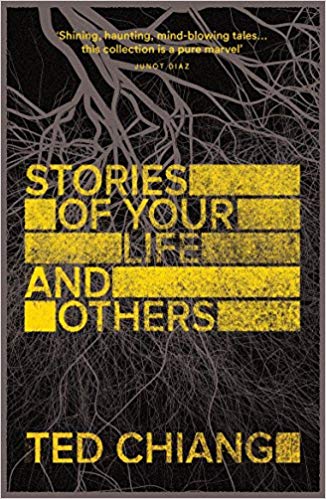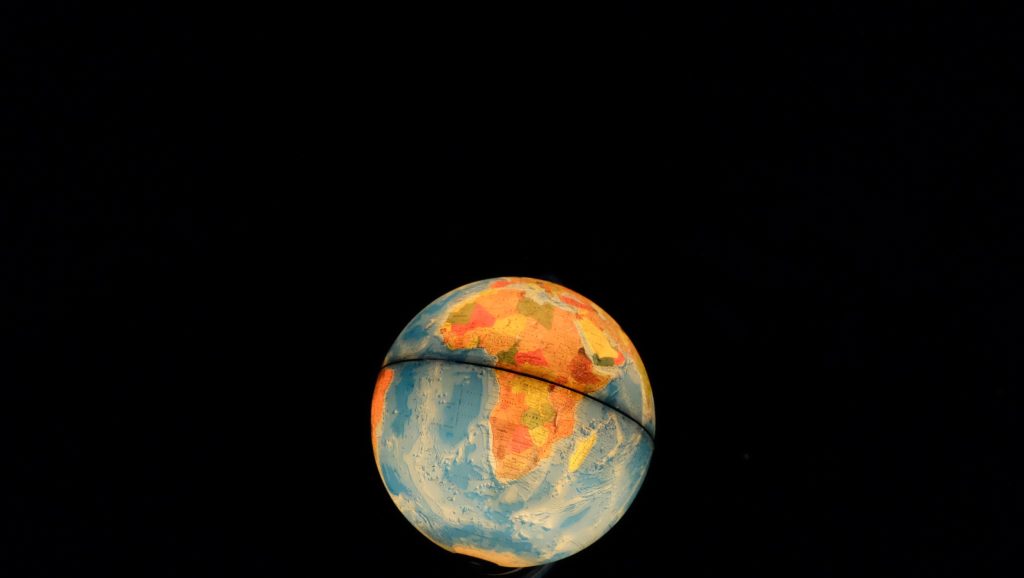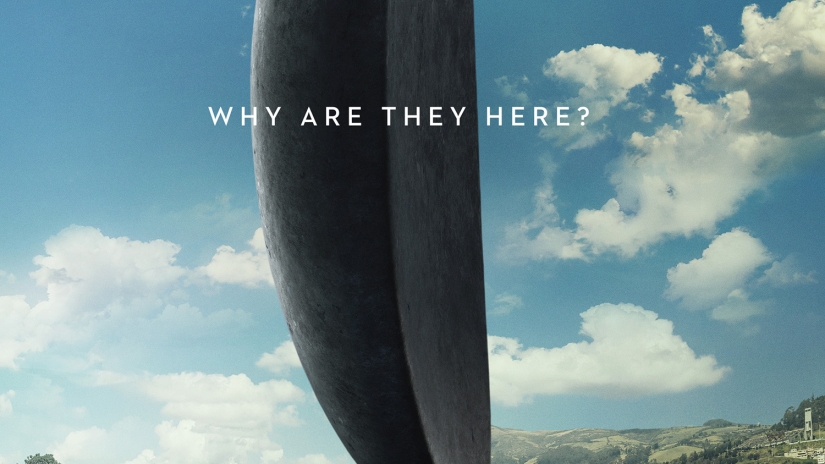Welcome back to our blog series “Have You Watched a Good Book Lately?” The series’ intention is to track a number of books’ progression from the printed page to the silver screen and assess how well or how badly the filmmakers accomplished each of the adaptations.
Today we’re going to be discussing “Story of Your Life,” a novella written by Ted Chiang that first appeared in Starlight 2 in 1998 and won the 1999 Theodore Sturgeon Award, was nominated for the 1999 Hugo Award for Best Novella, and won the 2000 Nebula Award for Best Novella. It was adapted for the screen in 2016 with the name “Arrival” by screenwriter Eric Heisserer and director Denis Villeneuve (“Sicario,” “Blade Runner 2049”). For those of you unfamiliar with the basic premise, here is a brief synopsis, first of the story (taken from Wikipedia) and then the film (adapted from the Blu-Ray cover):

The book cover
““Story of Your Life” is narrated by linguist Dr. Louise Banks the day her daughter is conceived. Addressed to her daughter, the story alternates between recounting the past: the coming of the aliens and the deciphering of their language; and remembering the future: what will happen to her unborn daughter as she grows up, and the daughter’s untimely death.”
“When mysterious alien spacecraft touch down across the globe, an elite team – led by expert translator Dr. Louise Banks (played by Amy Adams) – races against time to decipher their intent. As tensions mount between fearful governments, Banks discovers the aliens’ true purpose and, to avert global war, takes a chance that could threaten her life, and quite possibly humanity.”
From the Source’s Mouth
Let’s start our discussion with one of the main concerns of any story adaptation – how true is the film to the source material? That’s actually a tricky question in this case, and it has a two-pronged answer. First, we need to consider that there are some things that don’t translate from one language to another. Take, for example, the structure of a haiku. We are taught that this short Japanese poem should be written in five syllables/seven syllables/five syllables; however, that’s not exactly correct. In actuality, the “syllables” are “sound syllables,” or “Oto onsetsu” (音音節) in Japanese. There’s no English word that describes what these are satisfactorily, and so we approximate the correct structure by using the syllable description. So, what does that have to do with “Story of Your Life?” Ted Chiang’s story is written in such a richly imaginative and descriptive fashion that to try to translate it into another medium – say, film – is virtually impossible; the outcome will only approximate the beauty of the original at best and mutilate it at worst.

Movie or book?
When I started reading this novella for the first time, I was confused by Chiang’s use of language in a story where language serves as the foundation. “I remember what it’ll be like watching you when you are a day old,” Louise Banks says at one point to her unborn daughter. This seemed a direct contradiction of tenses. She remembered (the past) what it will be like sometime in the future, after her as-yet-unconceived daughter is born. Or another exchange:
“I remember the morgue, all tile and stainless steel, the hum of refrigeration and smell of antiseptic. An orderly will pull the sheet back to reveal your face. Your face will look wrong somehow, but I’ll know it’s you. … You’ll be twenty-five then.” Again, it’s a statement in the present indicating that in the future she’ll remember the past about an event that hasn’t even occurred.

One hundred twenty-eight “looking glasses” appeared around the world.
Louise Banks is a linguist, and she’s called in to serve as an emissary/interpreter when “ships appeared in orbit and artifacts appeared in meadows” – aliens had arrived, and humanity was in a first-contact situation as a result. One hundred twenty-eight “looking glasses” appeared around the world, and each one had a research team assigned to it. The heptapods, as the aliens were named, were willing subjects and took an active part in the communication process. They worked with the researchers trying to parse both their spoken and written languages. Each research team shared their results with all the others so a more complete picture of the aliens could be produced, and that’s how breakthroughs in understanding occurred.
What they discovered was astonishing. The heptapods had two distinct languages – Heptapod A, which was their spoken language, and Heptapod B, which was their written language. Heptapod A was strange enough – “It was clear that word order meant next to nothing when speaking Hepapod A; when asked to repeat what it had just said, a heptapod would likely as not use a different word order unless specifically asked not to.” Louise and her partner, physicist Gary Donnelly, wondered if the same would be true for Heptapod B: “As far as anyone could tell, there was no preferred order when reading the semagrams [word pictures] in a sentence; you could start almost anywhere in the nest, then follow the branching clauses until you’d read the whole thing. But that was reading; was the same true about writing?” What they discovered was that “the heptapod had to know how the entire sentence would be laid out before it could write the very first stroke. The other strokes [were] … so interconnected that none could be removed without redesigning the entire sentence.”
This sounds great, but what does it mean? It means that the heptapods had to have a working knowledge of how things had been, how they were now, and how they would be, and hold them in their minds all at the same time. Past, present, and future: “a simultaneous mode of consciousness.” Once Louise discovered that structure and understood that “there was no direction inherent in the way propositions were connected, no ‘train of thought’ moving along a particular route; all the components in an act of reasoning were equally powerful, all having identical precedence,” she was able to see her future as well as her past. She could “remember” when her daughter “will be born.” She understood that all perception is fluid. And once I understood what Louise had learned, the whole story’s language came into focus; I perceived the wonderful intricacy of thought, science, and communication Chiang created with this work.

The second prong of the source material answer is how do you translate this intricacy of language to film, an inherently visual, mostly linear medium? The answer is that you can’t, not in any truly meaningful way. You can only approximate the greatness of the words on the page with richly toned images or stunning landscapes or intimate moments between characters, but you will always be making an inferior copy. That’s exactly what happened with “Arrival.” There was no beauty in the words the characters spoke, no intricacy – it was mostly just standard dialogue to move the plot forward. Louise was less than communicative, which made her hard to read other than her obvious brilliance and passion for her work, and she often came off as merely surly. The other characters were thinly drawn (i.e. the Army colonel, the nice but less-than-stellar scientist, the military “grunts” following orders, the predictable foreign leaders fearing invasion, etc.), so there wasn’t much to appreciate or grab on to there. And while the cinematography was nice, it wasn’t stellar or ground-breaking (for example, there were long shots of the scientists moving up into the alien ship along a dark path during which nothing happened, and nice – but not strange – shots of the alien ship against the mountains). We both wanted and needed more.

The Arrival Movie Poster
There was an attempt as Louise became more conversant in Heptapod B at using flash-forwards of her daughter to convey the non-linearity of time, but there was no real indication that these were future and not past events. As a result, they did not make a great deal of sense in the story’s overall telling. Even near the end, where the Chinese general gives Louise information she will use in the past to convince him of the heptapods’ sincerity comes off as flat and puzzling – since we don’t know that past, present, and future are connected, we think she should have recognized that information as something she had already used in the past to change the future, but she doesn’t. It really isn’t until the very end, when we see Louise looking at a book she will publish many years down the line about the heptapod language that’s dedicated to her daughter, that we get even an inkling of how non-linearity is affecting her thoughts, and by that point it’s too late to save the clunky story.
Another major departure from the source material was (if you haven’t already guessed it from the story descriptions) the basic premise. In the novella, Chiang was intent on examining how language affects our thinking and our perception of ourselves and the universe around us. In the film, the story was about finding out why the aliens were here, determining how much of a threat they posed to humanity, and trying to prevent a global war in the process. Tensions mount. Researchers from one country won’t share their results with other countries. Someone panics and detonates a warhead on the ship Louise is studying, killing one of the heptapods in the process. Gone is science, investigation, cooperation, and learning – what we have is an action-adventure story that refuses to ask the audience to contemplate the hard questions it purportedly wants to provoke. One has to wonder why they bothered adapting an existing work and didn’t just come up with an original screenplay.

A scene from the film Arrival
Non-Standard Deviations
In addition to the basic plot, there were a number of other curious changes to the story. Instead of having orbiting ships and 128 looking glasses scattered around the globe, there were only 12 enormous ships, and they all came down to Earth. Instead of Louise’s unnamed daughter dying from a mountain climbing accident, she was named Hannah and contracted a rare illness. Instead of having round-the-clock access to the heptapods, who used their own technology to aid in the information exchange, a “window” opened every 18 hours to allow the humans to enter the ships, and the only technology used was by those humans – the heptapods were somehow a “non-technological” species, despite their ability to travel through space. And instead of learning about some of the fascinating intricacies of the aliens’ math and physics that went along with their unusual language, we only got didactically presented lessons from Louise about the grammar and structure of the language. There was more, but you get the point.
The Final Cut
So, how did “Arrival” as a movie fare as a story adaptation overall? Very, very badly – so much so that it was almost a completely different beast. I’d give it a D, not just for its mangling of exquisite language, but also for its lack of clarity and purpose.
What do you think? Do you agree? Disagree? Please add your comments in the section below.
– Miriam Ruff, Content Creator, PoetsIN
DISCLAIMER: The opinions discussed in this blog post are solely those of the blogger and do not necessarily represent any thoughts, values, or opinions of PoetsIN and any of its affiliate groups.
Please follow and like us:
Welcome back to our blog series “Have You Watched a Good Book Lately?” The series’ intention is to track a number of books’ progression from the printed page to the silver screen and assess how well or how badly the filmmakers accomplished each of the adaptations.
Today we’re going to be discussing “Story of Your Life,” a novella written by Ted Chiang that first appeared in Starlight 2 in 1998 and won the 1999 Theodore Sturgeon Award, was nominated for the 1999 Hugo Award for Best Novella, and won the 2000 Nebula Award for Best Novella. It was adapted for the screen in 2016 with the name “Arrival” by screenwriter Eric Heisserer and director Denis Villeneuve (“Sicario,” “Blade Runner 2049”). For those of you unfamiliar with the basic premise, here is a brief synopsis, first of the story (taken from Wikipedia) and then the film (adapted from the Blu-Ray cover):
The book cover
““Story of Your Life” is narrated by linguist Dr. Louise Banks the day her daughter is conceived. Addressed to her daughter, the story alternates between recounting the past: the coming of the aliens and the deciphering of their language; and remembering the future: what will happen to her unborn daughter as she grows up, and the daughter’s untimely death.”
“When mysterious alien spacecraft touch down across the globe, an elite team – led by expert translator Dr. Louise Banks (played by Amy Adams) – races against time to decipher their intent. As tensions mount between fearful governments, Banks discovers the aliens’ true purpose and, to avert global war, takes a chance that could threaten her life, and quite possibly humanity.”
From the Source’s Mouth
Let’s start our discussion with one of the main concerns of any story adaptation – how true is the film to the source material? That’s actually a tricky question in this case, and it has a two-pronged answer. First, we need to consider that there are some things that don’t translate from one language to another. Take, for example, the structure of a haiku. We are taught that this short Japanese poem should be written in five syllables/seven syllables/five syllables; however, that’s not exactly correct. In actuality, the “syllables” are “sound syllables,” or “Oto onsetsu” (音音節) in Japanese. There’s no English word that describes what these are satisfactorily, and so we approximate the correct structure by using the syllable description. So, what does that have to do with “Story of Your Life?” Ted Chiang’s story is written in such a richly imaginative and descriptive fashion that to try to translate it into another medium – say, film – is virtually impossible; the outcome will only approximate the beauty of the original at best and mutilate it at worst.
Movie or book?
When I started reading this novella for the first time, I was confused by Chiang’s use of language in a story where language serves as the foundation. “I remember what it’ll be like watching you when you are a day old,” Louise Banks says at one point to her unborn daughter. This seemed a direct contradiction of tenses. She remembered (the past) what it will be like sometime in the future, after her as-yet-unconceived daughter is born. Or another exchange:
“I remember the morgue, all tile and stainless steel, the hum of refrigeration and smell of antiseptic. An orderly will pull the sheet back to reveal your face. Your face will look wrong somehow, but I’ll know it’s you. … You’ll be twenty-five then.” Again, it’s a statement in the present indicating that in the future she’ll remember the past about an event that hasn’t even occurred.
One hundred twenty-eight “looking glasses” appeared around the world.
Louise Banks is a linguist, and she’s called in to serve as an emissary/interpreter when “ships appeared in orbit and artifacts appeared in meadows” – aliens had arrived, and humanity was in a first-contact situation as a result. One hundred twenty-eight “looking glasses” appeared around the world, and each one had a research team assigned to it. The heptapods, as the aliens were named, were willing subjects and took an active part in the communication process. They worked with the researchers trying to parse both their spoken and written languages. Each research team shared their results with all the others so a more complete picture of the aliens could be produced, and that’s how breakthroughs in understanding occurred.
What they discovered was astonishing. The heptapods had two distinct languages – Heptapod A, which was their spoken language, and Heptapod B, which was their written language. Heptapod A was strange enough – “It was clear that word order meant next to nothing when speaking Hepapod A; when asked to repeat what it had just said, a heptapod would likely as not use a different word order unless specifically asked not to.” Louise and her partner, physicist Gary Donnelly, wondered if the same would be true for Heptapod B: “As far as anyone could tell, there was no preferred order when reading the semagrams [word pictures] in a sentence; you could start almost anywhere in the nest, then follow the branching clauses until you’d read the whole thing. But that was reading; was the same true about writing?” What they discovered was that “the heptapod had to know how the entire sentence would be laid out before it could write the very first stroke. The other strokes [were] … so interconnected that none could be removed without redesigning the entire sentence.”
This sounds great, but what does it mean? It means that the heptapods had to have a working knowledge of how things had been, how they were now, and how they would be, and hold them in their minds all at the same time. Past, present, and future: “a simultaneous mode of consciousness.” Once Louise discovered that structure and understood that “there was no direction inherent in the way propositions were connected, no ‘train of thought’ moving along a particular route; all the components in an act of reasoning were equally powerful, all having identical precedence,” she was able to see her future as well as her past. She could “remember” when her daughter “will be born.” She understood that all perception is fluid. And once I understood what Louise had learned, the whole story’s language came into focus; I perceived the wonderful intricacy of thought, science, and communication Chiang created with this work.
The second prong of the source material answer is how do you translate this intricacy of language to film, an inherently visual, mostly linear medium? The answer is that you can’t, not in any truly meaningful way. You can only approximate the greatness of the words on the page with richly toned images or stunning landscapes or intimate moments between characters, but you will always be making an inferior copy. That’s exactly what happened with “Arrival.” There was no beauty in the words the characters spoke, no intricacy – it was mostly just standard dialogue to move the plot forward. Louise was less than communicative, which made her hard to read other than her obvious brilliance and passion for her work, and she often came off as merely surly. The other characters were thinly drawn (i.e. the Army colonel, the nice but less-than-stellar scientist, the military “grunts” following orders, the predictable foreign leaders fearing invasion, etc.), so there wasn’t much to appreciate or grab on to there. And while the cinematography was nice, it wasn’t stellar or ground-breaking (for example, there were long shots of the scientists moving up into the alien ship along a dark path during which nothing happened, and nice – but not strange – shots of the alien ship against the mountains). We both wanted and needed more.
The Arrival Movie Poster
There was an attempt as Louise became more conversant in Heptapod B at using flash-forwards of her daughter to convey the non-linearity of time, but there was no real indication that these were future and not past events. As a result, they did not make a great deal of sense in the story’s overall telling. Even near the end, where the Chinese general gives Louise information she will use in the past to convince him of the heptapods’ sincerity comes off as flat and puzzling – since we don’t know that past, present, and future are connected, we think she should have recognized that information as something she had already used in the past to change the future, but she doesn’t. It really isn’t until the very end, when we see Louise looking at a book she will publish many years down the line about the heptapod language that’s dedicated to her daughter, that we get even an inkling of how non-linearity is affecting her thoughts, and by that point it’s too late to save the clunky story.
Another major departure from the source material was (if you haven’t already guessed it from the story descriptions) the basic premise. In the novella, Chiang was intent on examining how language affects our thinking and our perception of ourselves and the universe around us. In the film, the story was about finding out why the aliens were here, determining how much of a threat they posed to humanity, and trying to prevent a global war in the process. Tensions mount. Researchers from one country won’t share their results with other countries. Someone panics and detonates a warhead on the ship Louise is studying, killing one of the heptapods in the process. Gone is science, investigation, cooperation, and learning – what we have is an action-adventure story that refuses to ask the audience to contemplate the hard questions it purportedly wants to provoke. One has to wonder why they bothered adapting an existing work and didn’t just come up with an original screenplay.
A scene from the film Arrival
Non-Standard Deviations
In addition to the basic plot, there were a number of other curious changes to the story. Instead of having orbiting ships and 128 looking glasses scattered around the globe, there were only 12 enormous ships, and they all came down to Earth. Instead of Louise’s unnamed daughter dying from a mountain climbing accident, she was named Hannah and contracted a rare illness. Instead of having round-the-clock access to the heptapods, who used their own technology to aid in the information exchange, a “window” opened every 18 hours to allow the humans to enter the ships, and the only technology used was by those humans – the heptapods were somehow a “non-technological” species, despite their ability to travel through space. And instead of learning about some of the fascinating intricacies of the aliens’ math and physics that went along with their unusual language, we only got didactically presented lessons from Louise about the grammar and structure of the language. There was more, but you get the point.
The Final Cut
So, how did “Arrival” as a movie fare as a story adaptation overall? Very, very badly – so much so that it was almost a completely different beast. I’d give it a D, not just for its mangling of exquisite language, but also for its lack of clarity and purpose.
What do you think? Do you agree? Disagree? Please add your comments in the section below.
– Miriam Ruff, Content Creator, PoetsIN
DISCLAIMER: The opinions discussed in this blog post are solely those of the blogger and do not necessarily represent any thoughts, values, or opinions of PoetsIN and any of its affiliate groups.
admin